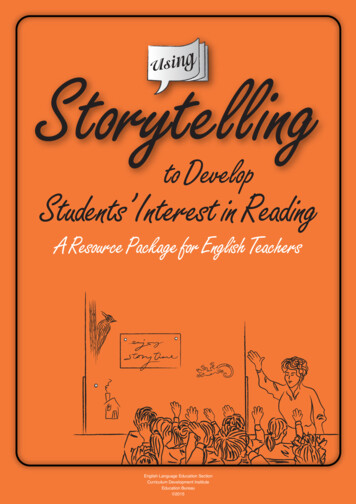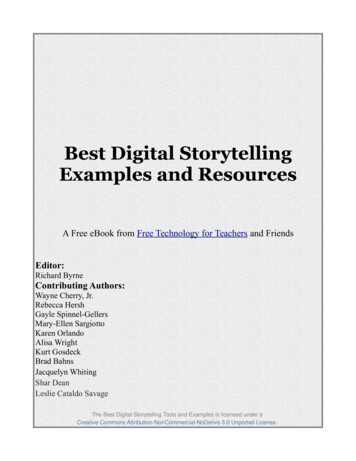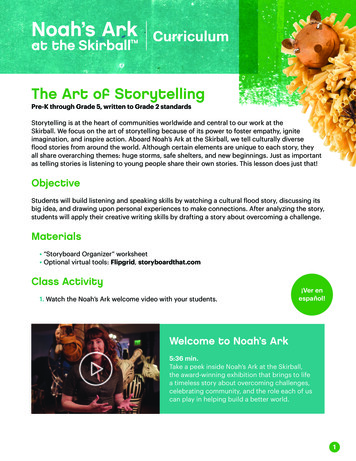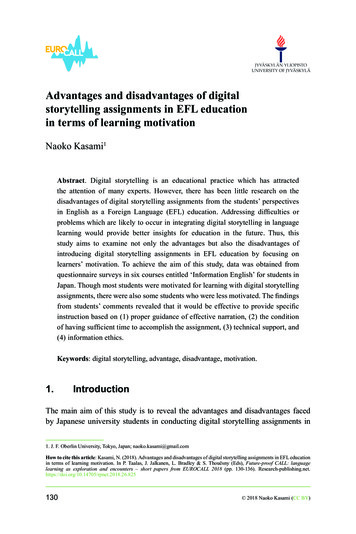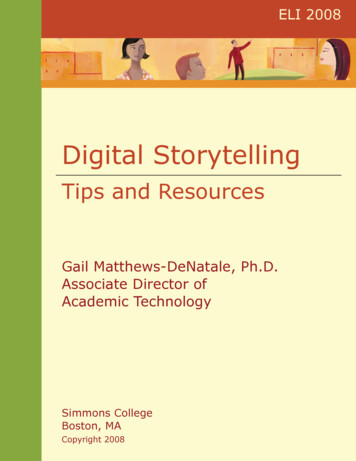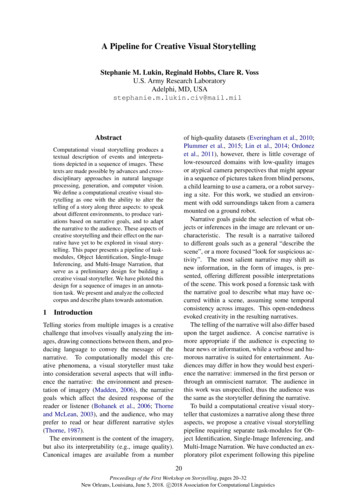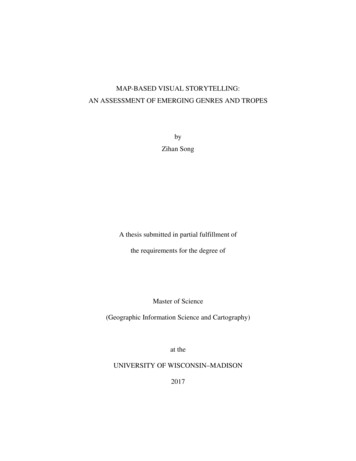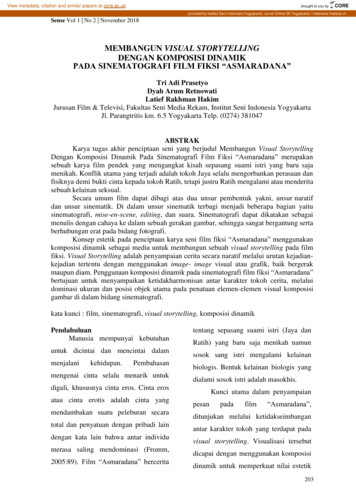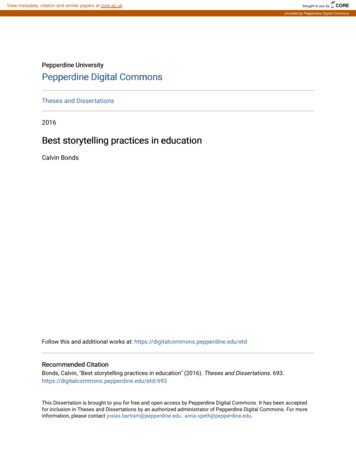
Transcription
View metadata, citation and similar papers at core.ac.ukbrought to you byCOREprovided by Pepperdine Digital CommonsPepperdine UniversityPepperdine Digital CommonsTheses and Dissertations2016Best storytelling practices in educationCalvin BondsFollow this and additional works at: ed CitationBonds, Calvin, "Best storytelling practices in education" (2016). Theses and Dissertations. his Dissertation is brought to you for free and open access by Pepperdine Digital Commons. It has been acceptedfor inclusion in Theses and Dissertations by an authorized administrator of Pepperdine Digital Commons. For moreinformation, please contact josias.bartram@pepperdine.edu , anna.speth@pepperdine.edu.
Pepperdine UniversityGraduate School of Education and PsychologyBEST STORYTELLING PRACTICES IN EDUCATIONA dissertation submitted in partial satisfactionof the requirements for the degree ofDoctor of Education in Organizational LeadershipbyCalvin BondsJuly, 2016Farzin Madjidi, Ed.D – Dissertation Chairperson
This dissertation, written byCalvin Bondsunder the guidance of a Faculty Committee and approved by its members, has been submitted toand accepted by the Graduate Faculty in partial fulfillment of the requirements for the degree ofDOCTOR OF EDUCATIONDoctoral CommitteeFarzin Madjidi, Ed.D., ChairpersonLani Simpao Fraizer, Ed.D.Gabriella Miramontes, Ed.D.
Copyright by Calvin Bonds (2016)All Rights Reserved
TABLE OF CONTENTSPageLIST OF TABLES . viLIST OF FIGURES . viiACKNOWLEDGEMENTS . viiiVITA . ixABSTRACT . xiChapter 1: Introduction to the Study . 1Statement of Problem . 7Purpose Statement . 9Research Questions . 9Significance of Study . 10Key Definitions . 11Key Assumptions . 13Limitations of the Study. 13Chapter Summary . 13Chapter 2: Literature Review . 14Overview of Storytelling. 14Effective Teaching Practices. 16Marzano’s Nine Instructional Strategies . 20Theoretical Case for Storytelling . 26Strategies in Storytelling . 30Evidence Related to Storytelling . 34Measures of Success in Storytelling . 38Chapter 3: Research Design And Methodology . 56Restatement of Research Questions . 56Nature of Study . 57Methodology . 59Research Design. 61Interview Protocol . 66Validity and Reliability . 68Statement of Personal Bias . 73Data Analysis . 74Inter-Rater Validity . 75Summary . 76
vPageChapter 4: Findings . 77Participants . 79Data Collection . 83Data Analysis . 85Data Display. 85Research Question 1 . 86Research Question 2 . 96Research Question 3 . 104Research Question 4 . 113Chapter Summary . 117Chapter Five: Conclusions and Recommendations . 120Summary of Results . 121Implications. 129Researcher’s Observations . 133Substantive Contribution . 134Aesthetic Merit. 134Reflexivity. 135Impact . 135Future Directions . 136Final Thoughts . 138REFERENCES . 141APPENDIX A: Research Questions and Interview Questions . 154APPENDIX B: Informed Consent Form . 155APPENDIX C: IRB Approval . 158
viLIST OF TABLESPageTable 1. Research and Interview Questions: Validation Table. 69Table 2. Research and Interview Questions: Review Table . 71Table 3. Participants in the Study, Their Educational Platform, and Their Connection toStorytelling . 80
viiLIST OF FIGURESPageFigure 1. Education and unemployment percentage comparisons in 2011 . 3Figure 2. Education and income comparisons in 2010 . 4Figure 3. Gender ratio of participants. . 81Figure 4. Ethnicity percentile of participants. . 81Figure 5. Age ranges of participants. . 82Figure 6. Role of storytelling in leadership practice. . 87Figure 7. How to incorporate stories in leadership practice. . 90Figure 8. Inspiration for stories. . 92Figure 9. Main sources of stories used. 94Figure 10. Elements for effective storytelling. . 97Figure 11. Downside to storytelling. 99Figure 12. Significant challenges in storytelling. . 101Figure 13. Assessing the extent of storytelling enhancement. . 105Figure 14. Awareness of non-resonating stories. . 107Figure 15. Addressing negative reactions. . 110Figure 16. Advice for new storytellers. . 113
viiiACKNOWLEDGEMENTSIt is with great appreciation that I acknowledge the dissertation committee who was myguide throughout this process. Thank you helping me to make this dream a reality. To mydissertation committee members:Farzin Madjidi, Ed.D. ChairpersonLani Simpao Fraizer, Ed.D.Gabriella Miramontes, Ed.D.I also want to thank my family and friends for encouraging me. This is your degree asmuch as it is mine. Thank you for every kind word and every uplifting moment.
ixVITAEDUCATION AND CERTIFICATIONSPEPPERDINE UNIVERSITY, Malibu, CADoctorate Candidate, Organizational Leadership2016UNITED STATES GOVERNMENT, Washington, D.C.Leadership Training Contractor Certification (DUNS 07-948-6398 and SAMS)2014WESTCLIFF UNIVERSITY, Cerritos, CATESOL Certificate, English Language Learners2012UNIVERSITY OF PHOENIX, Phoenix, AZ(M.Ed.) Master in Education and Training2011IRVINE UNIVERSITY, Cerritos, CA(M.B.A) Executive Master’s of Business Administration2006LEMOYNE-OWENS COLLEGE, Memphis, TN(B.A.) Bachelor of Arts, English, Music2000EXPERIENCECBONDS ENTERPRISESGlobal Leadership Training Consultant/ Master Storyteller. .May 2012 – Present Conduct leadership training to various management and frontline employees within companies throughinteractive storytelling and role playing (www.bondstorytelling.com)o Example: Diversity and Inclusion Training (High Level Program Design, Training) addressingminorities, gender, age (generational differences), sexual orientation, education, disability,height/weight, ELS (English Language Learners), etc. Drive sales, increase production, and create and maintain a high performance environment within theworkplace. Construct stories to explain complex systems, policies and procedures for global entities. Foster strong relationships within organizations, and with multiple organizations through “systemsthinking” learning and the impact of “community of practice.” Provide team training to ensure that departments are in compliance with applicable, regulatory, andstatutory regulations. Train the trainers to align with the organization’s mission, culture, and understanding of diverse employeesthrough emotional intelligence Use leadership training to encourage results-oriented performanceCALVIN WALKER COMMUNITY BUILDING, Los Angeles, CANonprofit Organization, Co-Founder .June 2006 – Present Train teachers on Department of Education Standards. Facilitate business workshops to participants in the urban community. Develop and implement afterschool programs for schools within Los Angeles. Design anti-bullying campaign for urban organizations that work with students. Compose and design curricula for nonprofit and for-profit organizations. Teach Adobe Photoshop and Illustrator to students in the community. Introduce the business of fashion and entertainment to Upward Bound Students (CSU Channel Islands).
xOCCASSIONS and EVENTS, Lagos, Nigeria.Leadership Trainer / Event Coordinator (Part-time) . .Jan. 2009 – Dec. 2009 Trained employees on leadership skills such aso Team Building, Supervisory Skills, Foundational Leadership, Diversity, Conflict Resolution, TimeManagement, Etc. Planned marketing and promotion eventsSILVERBIRD ENTERTAINMENTLagos, Nigeria (Africa)January 2009 – Dec 2009Leadership Trainer / Project Coordinator Consultant Incorporated Marketing and Promotions for upcoming events Spearheaded the creative team for production of various entertainment projects (television shows, fashionshows, etc) Organized events for the Silverbird Galleria (Mall attached to the Entertainment group) Interviewed and Hired Employees to work in the various sectors of the Entertainment DepartmentLOS ANGELES UNIFIED SCHOOL DISTRICT (LAUSD), Los Angeles, CAHigh School Instructor .Feb 2005 –May 2012 Delivered Standards-based instruction in English and English as a Second Language (ESL) to GeneralEducation and mild-to-moderate disabled students in a Special Day Class.VOA TRIO UPWARD BOUND, Los Angeles, CA.Educational Advisor/Project Coordinator .March 2002 – Feb. 2005 Trained and supervised teachers, tutors, and other staff on leadership Provided guidance, direction and support to participants that come from inner-city environments. Advised students in the areas of program and admissions requirements, admission status, financial aid andthe transfer of credits from other institutions. Evaluated test scores, previous education, and transfer credits for applicant eligibility. Developed and implemented SAT preparation workshops for program participants. Helped graduates get accepted to colleges and universities.FRITZ COMPANIES FEDEX TRADE NETWORKS INC, Memphis, TN.Import Coordinator in Brokerage . .April 1999 – Feb. 2002 Tracked shipments and met quotas Filled out import documentation, compiling carrier route assignments Developed a good rapport and “peace of mind” about their packages and the shipping process. Communicated with claims insurance companies when necessary. Coordinated shipping for custom agents for clearance with overseas deliveriesACCOLADES/ACHIEVEMENTS/PROFESSIONAL AFFILIATIONSCerritos Chamber of Commerce (Ambassador)B-Lions ClubNorwalk Chamber of CommerceAlpha Phi Alpha Fraternity, Inc.Lakewood Chamber of CommerceDowney Chamber of CommerceWho’s Who Among American Colleges and UniversitiesCommunity Collaborative Network, Cerritos
xiABSTRACTEffective teaching strategies can be defined as utilizing the higher levels of Bloom’s taxonomy,which include understanding, application and analysis (Flynn, Mesibov, Vermette & Smith,2004). Teachers that use effective teaching strategies can significantly impact the future earningsof their students. Students that are recipients of these strategies receive a higher quality of K-12education, which leads to a higher caliber of colleges and universities chosen. As a result of thehigher education institutions attended, students become more competitive when entering anevolving workforce, earning higher salaries. This study explores the effective teaching strategyof storytelling. It identifies best practices of storytelling leaders in education. The literaturereveals a link between successful storytelling practices and adult learning theory. There is also aconnection between the impact of storytelling and the neuroscience of the brain. The findings areexpected to help leaders in education who want to practice storytelling in their leadershippractice. As a result of interviewing participants in this study, several themes were discoveredthat pointed out key factors in best storytelling practices. Some key findings include using storiesto encourage critical thinking skills, heighten self-awareness among students, and activate braintriggers that produce an emotional connection around a subject matter. The data collected instudy is believed to contribute to the effectiveness of future storytellers who wish to usestorytelling as an effective teaching strategy in their leadership practice.Keywords: Effective Teaching Strategies, Storytelling, Adult Learning Theory, Neuroscience
1Chapter 1: Introduction to the StudyThe objective of this phenomenological study was to explore best practices of storytellingleaders as effective teaching strategies. Specifically, K-12 and higher education teachers wereinterviewed. The study sought to use the data to compile themes that could be used to helpcurrent teachers and future teachers who could use storytelling as an effective teaching strategy.The following story will illustrate the intent of the study:One day a young lady was driving along with her father. They came upon a storm and theyoung lady asked her father, “What should I do?”Father said, “Keep driving.” Cars began to pull over to the side, the storm wasgetting worse.“What should I do?” The young lady asked?“Keep driving,” her father replied.On up a few feet, she noticed that eighteen-wheelers were also pulling over. Shetold her father, “I must pull over, I can barely see ahead. It is terrible and everyone ispulling over!”Her father told her, “Don’t give up, just keep driving!”Now the storm was terrible, but she never stopped driving and soon she could seea little more clearly. After a couple of miles she was again on dry land and the sun cameout.Her father said, “Now you can pull over and get out.”Young Lady said, “But why now?”Father said, “When you get out, look back at all the people that gave up and arestill in the storm, because you never gave up your storm is now over.”
2This is a testimony for anyone who is going through “hard times.” Just becauseeveryone else, even the strongest, gives up. You don’t have to . if you keep going, soonyour storm will be over and the Sun will shine upon your face again. (Syed, 2015,para. 1)In the classroom, stories like these can be used to encourage students to continue workinghard although they may have a tough year ahead in learning. In sharing such a story withstudents, teachers would be performing an act of compassion, making a connection with studentsand tapping into their emotions. Indeed, storytelling is one of the many ways teachers can impactthe lives of students.A teacher’s impact on their students is crucial because it can lead to a change in futureearnings. Economists Raj Chetty and John Friedman of Harvard University and Jonah Rockoff ofColumbia University (as cited in Lee-Chua, 2013) studied 20 years of data on over a millionpupils in a metropolitan school district, including information on parents’ tax records andteachers’ performance within schools. They found that improvements in the quality of teachingby value-added (VA) teachers had a direct correlation to the quality of colleges attended by theVA teachers’ students. VA refers to changes that teachers can make on instructional strategies.Ultimately the earnings of students proved to be higher because the quality of education madethem more competitive in the workforce. Therefore, teachers’ influence on students’ futureearnings also inadvertently affects unemployment rates.The rate of unemployment in the U.S. decreased to 5% October of 2015 from 5.7 % inJanuary of 2015 (U.S. Department of Labor, 2015). This means that out of the 7.9 million peoplewho were unemployed in January 2015, 1.1 million of them found jobs by October 2015. This5% serves as a midpoint, considering the fact that from 1948 until 2015 the highest
3unemployment rate has been 10.80% in November 1982. Conversely, the lowest unemploymentwas 2.5% in May 1953 (Trading Economics, 2015).Education contributes to the aforementioned unemployment percentages because it has adirect effect on unemployment (Robicheaux, 2011). The better a person in a particularcommunity is educated, the less unemployment that community endures. Education levels causeunemployment percentages to vary. Figure 1 summarizes variations of unemployment based oneducation levels. Figure 2 shows average yearly income based on education levels.Figure 1. Education and unemployment percentage comparisons in 2011. Adapted from“Education Affects Unemployment Suffering,” by R. Robicheaux, 2011, retrieved fromhttp://blog.al.com/businessnews/2011/09/bob robicheaux education affec.html. Copyright 2011by the author.
4Figure 2. Education and income comparisons in 2010. Adapted from “Education AffectsUnemployment Suffering,” by R. Robicheaux, 2011, retrieved fromhttp://blog.al.com/businessnews/2011/09/bob robicheaux education affec.html. Copyright 2011by the author.K-12 schools and higher education institutions are working together to make surestudents are educated and prepared for the working world. There are connections amongeducation, future earnings, and unemployment. These organizations understand the impact ofeducation on future leaders in the workplace. One initiative that is currently in process is thepartnership of Common Core State Standards (CCSS) with the Partnership of Readiness forCollege and Careers (PARCC).The CCSS is a set of academic standards in Mathematics and English LanguageArts/literacy (ELA) that provides guidelines for a student’s knowledge and capabilities at the endof each grade, with the aim of being college and career ready. These standards were designed tohelp students achieve the same levels of education regardless of their socio-economicbackground. As a result of CCSS, students should graduate with a heightened awareness of
5reading, writing, speaking and listening, and language. Common Core gives teachers theindependence to motivate students to learn as long as each student is able to show what theyhave learned at the conclusion of the academic school year (Common Core State StandardsInitiative, 2015).The Partnership of Readiness for College and Careers (PARCC, n.d.) is a group of statesworking together to develop an assessment in lieu of 11th grade standardized tests that align withCCSS. It also helps teachers and parents identify a student’s learning needs, as well as where thatstudent may be excelling. In parallel to the CCSS, this assessment is designed to help students,regardless of their socio-economic status, gain access to an equal education that will preparethem for college and careers. This assessment benefits higher education teachers by informingthem of each student’s performance levels when entering their institutions. Then, the teacher’sjob is to motivate students to learn at those starting levels.In this partnership, Common Core sets the expectations for each grade, whereas PARCCprovides a valid and reliable evaluation of each student’s progress toward those expectations(PARCC, n.d.). Based on the students’ results of the PARCC assessments, they possibly wouldenter into entry-level, credit bearing courses at postsecondary institutions without remediation inELA/Literacy and/or Math. This guaranteed exemption from taking remedial classes isacknowledged in conjunction with more than 700 colleges and universities. Whether instructingstudents in alignment with the Common Core Standards, or reviewing PARCC assessments,teachers must find ways to motivate students to learn, regardless of conditions or backgrounds.In the 2012-2013 academic year, there were 6,299,451 K-12 students enrolled inCalifornia alone (California Department of Education, 2015). This population consisted of thefollowing ethnic groups: White, Asian/Pacific Islander, Hispanic, Black, and Native American.
6Each culture comes with different influences and learning approaches. It is the job of teachers tomake sure their instructional strategies are effective enough so that all unique studentpopulations acquire knowledge through engaging and interesting teaching, especially in view ofthe fact that a lack of efficacy could lead to long-term negative consequences. Ineffectiveteaching strategies could lead to a lack of interest that ultimately could result in student dropout(“Why Teens Drop Out of School,” 2008).In 2008, a study conducted with 5,000 high school students across the United Statesshowed that lack of interest was the leading reason that students dropped out of school betweenthe 10th and 12th grade. Other reasons included insufficient educational support, outsideinfluences, special needs, financial problems, substance abuse, depression and illness, physicalabuse, teenage pregnancy, and alternative lifestyles. The numbers showed that 70% of the highschool dropouts complained about losing interest in the curriculum because of the way it wasbeing taught (“Why Teens Drop Out of School,” 2008). Teachers motivate students to learn; it istheir job to stimulate students’ minds and keep students engaged. Because they facilitatelearning, teachers have a moral responsibility to motivate students by any effective teachingstrategy necessary (Fredriksen & Rhodes, 2004).Having an effective teaching strategy is important because it can help students focus onthe material (Hussain, 2015). Far too often, students are not engaged in lessons because of a lackof focus, which can be attributed to many factors, including but not limited to socialcircumstances or emotional pressures that are beyond their control. It then becomes the teacher’sjob to employ effective strategies to provide a welcome environment where the student canengage in learning while he or she is in class. Furthermore, by employing effective teachingstrategies, a teacher can clear up any misconceptions about the material. A seemingly
7disinterested student may actually be struggling to grasp what is being taught. Asking studentsto repeat was said is one strategy that can increase chances of learning because by doing so, theyare able to hear the lesson once the first time, and then again when they say what they learnedaloud. Repeating what the teacher says also allows students to become more engaged throughparticipation. This element of student participation is an essential factor in learning. Teachers canalso use a group of instructional teaching strategies to ensure learning is happening. Educationalleader Robert J. Marzano conducted a meta-analysis of various instructional strategies thatteachers often use in the classroom to determine which ones were effective. As a result, he cameup with nine instructional strategies best used in the classroom, one of which is reinforcingrecognition, which is affirming student achievement through positive words. Teachers often userecognition in helping a student feel proud of his/her accomplishments (Marzano, Pickering, &Pollock, 2001).Statement of ProblemThe need for storytelling. Effective strategies are critically important in helping studentsfrom diverse backgrounds access learning. As stated by Chen (2005), the majority of firstgeneration college students are immigrants of color, 24 or older and from low socioeconomicbackgrounds. In 2004, 42% of students in elementary and secondary schools were people ofcolor. These categories included Black, Hispanic, Asian/ Pacific Islander, and AmericanIndian/Alaskan Native (National Center for Education Statistics [NCES], 2007). Although thenumbers of minorities in education are rising, larger institutions have failed to foster success inthese student groups. Studies show that students from diverse backgrounds can easily be isolatedon a college campus and feel marginalized when they are not around others from the sameethnicity (Richardson & Skinner, 1992). Cultivating narratives in learning environments through
8storytel
https://digitalcommons.pepperdine.edu/etd/693 This Dissertation is brought to you for free and open access by Pepperdine Digital Commons. It has been accepted for inclusion in Theses and Dissertations by an authorized administrator of Pepperdine Digital Commons. For more information, please contact josias.bartram@pepperdine.edu , anna.speth .
